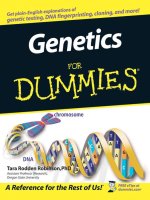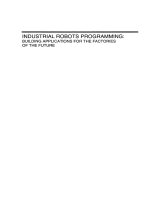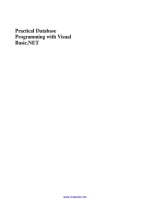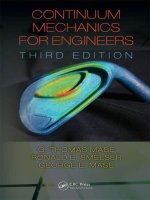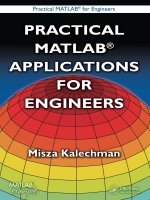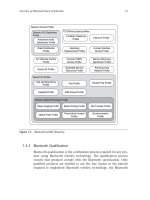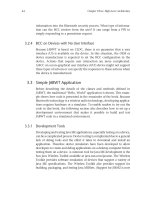matlab programming with applications for engineers 1st edition
Bạn đang xem bản rút gọn của tài liệu. Xem và tải ngay bản đầy đủ của tài liệu tại đây (9.01 MB, 594 trang )
68077_00_fm_pi-xx.qxd
9/2/11
1:49 PM
Page i
MATLAB®
Programming
with Applications
for Engineers
Copyright 2012 Cengage Learning. All Rights Reserved. May not be copied, scanned, or duplicated, in whole or in part. Due to electronic rights, some third party content may be suppressed from the eBook and/or eChapter(s). Editorial review has
deemed that any suppressed content does not materially affect the overall learning experience. Cengage Learning reserves the right to remove additional content at any time if subsequent rights restrictions require it.
68077_00_fm_pi-xx.qxd
9/2/11
1:49 PM
Page ii
Copyright 2012 Cengage Learning. All Rights Reserved. May not be copied, scanned, or duplicated, in whole or in part. Due to electronic rights, some third party content may be suppressed from the eBook and/or eChapter(s). Editorial review has
deemed that any suppressed content does not materially affect the overall learning experience. Cengage Learning reserves the right to remove additional content at any time if subsequent rights restrictions require it.
68077_00_fm_pi-xx.qxd
9/2/11
1:49 PM
Page iii
MATLAB®
Programming
with Applications
for Engineers
First Edition
Stephen J. Chapman
BAE Systems Australia
Australia • Brazil • Japan • Korea • Mexico • Singapore • Spain • United Kingdom • United States
Copyright 2012 Cengage Learning. All Rights Reserved. May not be copied, scanned, or duplicated, in whole or in part. Due to electronic rights, some third party content may be suppressed from the eBook and/or eChapter(s). Editorial review has
deemed that any suppressed content does not materially affect the overall learning experience. Cengage Learning reserves the right to remove additional content at any time if subsequent rights restrictions require it.
68077_00_fm_pi-xx.qxd
9/2/11
1:49 PM
Page iv
MATLAB® Programming with Applications
for Engineers
Stephen J. Chapman
Publisher, Global Engineering: Christopher
M. Shortt
Senior Acquisitions Editor: Randall Adams
Senior Developmental Editor: Hilda Gowans
© 2013 Cengage Learning
ALL RIGHTS RESERVED. No part of this work covered by the copyright
herein may be reproduced, transmitted, stored, or used in any form or by
any means graphic, electronic, or mechanical, including but not limited to
photocopying, recording, scanning, digitizing, taping, web distribution,
information networks, or information storage and retrieval systems, except
as permitted under Section 107 or 108 of the 1976 United States
Copyright Act, without the prior written permission of the publisher.
Editorial Assistant: Tanya Altieri
Team Assistant: Carly Rizzo
Marketing Manager: Lauren Betsos
Media Editor: Chris Valentine
Content Project Manager: D. Jean Buttrom
Production Service: RPK Editorial Services, Inc.
For product information and technology assistance, contact us at
Cengage Learning Customer & Sales Support, 1-800-354-9706.
For permission to use material from this text or product,
submit all requests online at www.cengage.com/permissions.
Further permissions questions can be emailed to
Copyeditor: Shelly Gerger-Knechtl
Proofreader: Harlan James
Library of Congress Control Number: 2011934123
Indexer: Shelly Gerger-Knechtl
ISBN-13: 978-0-495-66807-7
Compositor: Integra Software Solutions
ISBN-10: 0-495-66807-9
Senior Art Director: Michelle Kunkler
Internal Designer: Carmela Periera
Cover Designer: Andrew Adams/4065042
Canada Inc.
Cover Image: © ivn3da/Shutterstock;
© Martin Trajkovski/Shutterstock;
© Daisy Daisy/Shutterstock;
© PhotoStocker/Shutterstock
Rights Acquisitions Specialist: John Hill
Text and Image Permissions Researcher:
Kristiina Paul
Senior First Print Buyer: Doug Wilke
Cengage Learning
200 First Stamford Place, Suite 400
Stamford, CT 06902
USA
Cengage Learning is a leading provider of customized learning solutions
with office locations around the globe, including Singapore, the United
Kingdom, Australia, Mexico, Brazil, and Japan. Locate your local office at:
international.cengage.com/region.
Cengage Learning products are represented in Canada by
Nelson Education Ltd.
For your course and learning solutions, visit www.cengage.com/engineering.
Purchase any of our products at your local college store or at our preferred
online store www.cengagebrain.com.
MATLAB is a registered trademark of The MathWorks, Inc., 3 Apple Hill
Drive, Natick, MA.
Printed in the United States of America
1 2 3 4 5 6 7 13 12 11
Copyright 2012 Cengage Learning. All Rights Reserved. May not be copied, scanned, or duplicated, in whole or in part. Due to electronic rights, some third party content may be suppressed from the eBook and/or eChapter(s). Editorial review has
deemed that any suppressed content does not materially affect the overall learning experience. Cengage Learning reserves the right to remove additional content at any time if subsequent rights restrictions require it.
This is an electronic version of the print textbook. Due to electronic rights restrictions, some third party content may be suppressed. Editorial
review has deemed that any suppressed content does not materially affect the overall learning experience. The publisher reserves the right to
remove content from this title at any time if subsequent rights restrictions require it. For valuable information on pricing, previous
editions, changes to current editions, and alternate formats, please visit www.cengage.com/highered to search by
ISBN#, author, title, or keyword for materials in your areas of interest.
Copyright 2012 Cengage Learning. All Rights Reserved. May not be copied, scanned, or duplicated, in whole or in part. Due to electronic rights, some third party content may be suppressed from the eBook and/or eChapter(s). Editorial review has
deemed that any suppressed content does not materially affect the overall learning experience. Cengage Learning reserves the right to remove additional content at any time if subsequent rights restrictions require it.
68077_00_fm_pi-xx.qxd
9/2/11
1:49 PM
Page v
This book is dedicated with love to my daughter Sarah Rivkah Chapman. As a student at
Swinburne University in Melbourne, she may actually wind up using it!
Copyright 2012 Cengage Learning. All Rights Reserved. May not be copied, scanned, or duplicated, in whole or in part. Due to electronic rights, some third party content may be suppressed from the eBook and/or eChapter(s). Editorial review has
deemed that any suppressed content does not materially affect the overall learning experience. Cengage Learning reserves the right to remove additional content at any time if subsequent rights restrictions require it.
68077_00_fm_pi-xx.qxd
9/2/11
1:49 PM
Page vi
About the Author
vi
Stephen J. Chapman received a BS in Electrical Engineering from Louisiana State
University (1975), an MSE in Electrical Engineering from the University of
Central Florida (1979), and pursued further graduate studies at Rice University.
From 1975 to 1980, he served as an officer in the U.S. Navy, assigned to
teach Electrical Engineering at the U.S. Naval Nuclear Power School in Orlando,
Florida. From 1980 to 1982, he was affiliated with the University of Houston,
where he ran the power systems program in the College of Technology.
From 1982 to 1988 and from 1991 to 1995, he served as a Member of the
Technical Staff of the Massachusetts Institute of Technology’s Lincoln
Laboratory, both at the main facility in Lexington, Massachusetts, and at the field
site on Kwajalein Atoll in the Republic of the Marshall Islands. While there, he
did research in radar signal processing systems. He ultimately became the leader
of four large operational range instrumentation radars at the Kwajalein field site
(TRADEX, ALTAIR, ALCOR, and MMW).
From 1988 to 1991, Mr. Chapman was a research engineer in Shell
Development Company in Houston, Texas, where he did seismic signal processing research. He was also affiliated with the University of Houston, where he continued to teach on a part-time basis.
Mr. Chapman is currently Manager of Systems Modeling and Operational
Analysis for BAE Systems Australia, in Melbourne, Australia. He is the leader of
a team that has developed a model of how naval ships defend themselves against
antiship missile attacks. This model contains more than 400,000 lines of
MATLABTM code written over more than a decade, so he has extensive practical
experience applying MATLAB to real-world problems.
Mr. Chapman is a Senior Member of the Institute of Electrical and Electronic
Engineers (and several of its component societies). He is also a member of the
Association for Computing Machinery and the Institution of Engineers (Australia).
Copyright 2012 Cengage Learning. All Rights Reserved. May not be copied, scanned, or duplicated, in whole or in part. Due to electronic rights, some third party content may be suppressed from the eBook and/or eChapter(s). Editorial review has
deemed that any suppressed content does not materially affect the overall learning experience. Cengage Learning reserves the right to remove additional content at any time if subsequent rights restrictions require it.
68077_00_fm_pi-xx.qxd
9/2/11
1:49 PM
Page vii
Contents
Chapter 1
1.1
1.2
1.3
1.4
1.5
1.6
Introduction to MATLAB
1
The Advantages of MATLAB 2
Disadvantages of MATLAB 4
The MATLAB Environment 4
1.3.1 The MATLAB Desktop 4
1.3.2 The Command Window 6
1.3.3 The Command History Window 7
1.3.4 The Start Button 7
1.3.5 The Edit/Debug Window 9
1.3.6 Figure Windows 9
1.3.7 Docking and Undocking Windows 11
1.3.8 The MATLAB Workspace 11
1.3.9 The Workspace Browser 12
1.3.10 Getting Help 13
1.3.11 A Few Important Commands 15
1.3.12 The MATLAB Search Path 17
Using MATLAB as a Calculator 19
Summary 21
1.5.1 MATLAB Summary 22
Exercises 22
vii
Copyright 2012 Cengage Learning. All Rights Reserved. May not be copied, scanned, or duplicated, in whole or in part. Due to electronic rights, some third party content may be suppressed from the eBook and/or eChapter(s). Editorial review has
deemed that any suppressed content does not materially affect the overall learning experience. Cengage Learning reserves the right to remove additional content at any time if subsequent rights restrictions require it.
68077_00_fm_pi-xx.qxd
9/2/11
1:49 PM
Page viii
viii | Contents
Chapter 2
MATLAB Basics
2.1
2.2
2.3
2.4
2.5
2.6
2.7
2.8
2.9
2.10
2.11
2.12
2.13
2.14
25
Variables and Arrays 25
Creating and Initializing Variables in MATLAB 29
2.2.1 Initializing Variables in Assignment Statements 29
2.2.2 Initializing with Shortcut Expressions 32
2.2.3 Initializing with Built-in Functions 33
2.2.4 Initializing Variables with Keyboard Input 33
Multidimensional Arrays 35
2.3.1 Storing Multidimensional Arrays in Memory 37
2.3.2 Accessing Multidimensional Arrays with One Dimension 37
Subarrays 39
2.4.1 The end Function 39
2.4.2 Using Subarrays on the Left-hand Side of an Assignment
Statement 40
2.4.3 Assigning a Scalar to a Subarray 41
Special Values 42
Displaying Output Data 44
2.6.1 Changing the Default Format 44
2.6.2 The disp function 46
2.6.3 Formatted output with the fprintf function 46
Data Files 48
Scalar and Array Operations 50
2.8.1 Scalar Operations 51
2.8.2 Array and Matrix Operations 51
Hierarchy of Operations 54
Built-in MATLAB Functions 57
2.10.1 Optional Results 58
2.10.2 Using MATLAB Functions with Array Inputs 58
2.10.3 Common MATLAB Functions 58
Introduction to Plotting 60
2.11.1 Using Simple xy Plots 61
2.11.2 Printing a Plot 62
2.11.3 Exporting a Plot as a Graphical Image 62
2.11.4 Saving a Plot in a Figure File 63
2.11.5 Multiple Plots 63
2.11.6 Line Color, Line Style, Marker Style, and Legends 64
Examples 68
MATLAB Applications:Vector Mathematics 74
2.13.1 Vector Addition and Subtraction 76
2.13.2 Vector Multiplication 77
MATLAB Applications: Matrix Operations
and Simultaneous Equations 81
2.14.1 The Matrix Inverse 82
Copyright 2012 Cengage Learning. All Rights Reserved. May not be copied, scanned, or duplicated, in whole or in part. Due to electronic rights, some third party content may be suppressed from the eBook and/or eChapter(s). Editorial review has
deemed that any suppressed content does not materially affect the overall learning experience. Cengage Learning reserves the right to remove additional content at any time if subsequent rights restrictions require it.
68077_00_fm_pi-xx.qxd
9/2/11
1:49 PM
Page ix
Contents
| ix
2.15 Debugging MATLAB Programs 84
2.16 Summary 86
2.16.1 Summary of Good Programming Practice 86
2.16.2 MATLAB Summary 87
2.17 Exercises 90
Chapter 3
3.1
3.2
3.3
3.4
3.5
3.6
3.7
Chapter 4
Two-Dimensional Plots
103
Additional Plotting Features for Two-Dimensional Plots 103
3.1.1 Logarithmic Scales 104
3.1.2 Controlling x- and y-axis Plotting Limits 107
3.1.3 Plotting Multiple Plots on the Same Axes 110
3.1.4 Creating Multiple Figures 111
3.1.5 Subplots 111
3.1.6 Controlling the Spacing Between Points on a Plot 114
3.1.7 Enhanced Control of Plotted Lines 117
3.1.8 Enhanced Control of Text Strings 118
Polar Plots 121
Annotating and Saving Plots 123
Additional Types of Two-Dimensional Plots 126
Using the plot function with Two-Dimensional Arrays 131
Summary 133
3.6.1 Summary of Good Programming Practice 134
3.6.2 MATLAB Summary 134
Exercises 135
Branching Statements and Program Design 139
4.1
4.2
4.3
4.4
4.5
4.6
Introduction to Top-Down Design Techniques 140
Use of Pseudocode 143
Relational and Logic Operators 144
4.3.1 Relational Operators 144
4.3.2 A Caution About The == And ϳ= Operators 146
4.3.3 Logic Operators 147
4.3.4 Logical Functions 151
Branches 153
4.4.1 The if Construct 154
4.4.2 Examples Using if Constructs 156
4.4.3 Notes Concerning the Use of if Constructs 162
4.4.4 The switch Construct 164
4.4.5 The try/catch Construct 166
More on Debugging MATLAB Programs 173
MATLAB Applications: Roots of Polynomials 178
Copyright 2012 Cengage Learning. All Rights Reserved. May not be copied, scanned, or duplicated, in whole or in part. Due to electronic rights, some third party content may be suppressed from the eBook and/or eChapter(s). Editorial review has
deemed that any suppressed content does not materially affect the overall learning experience. Cengage Learning reserves the right to remove additional content at any time if subsequent rights restrictions require it.
68077_00_fm_pi-xx.qxd
9/2/11
1:49 PM
Page x
x | Contents
4.7
4.8
Chapter 5
Summary 181
4.7.1 Summary of Good Programming Practice 181
4.7.2 MATLAB Summary 182
Exercises 182
Loops and Vectorization
The while Loop 189
The for Loop 195
5.2.1 Details of Operation 202
5.2.2 Vectorization: A Faster Alternative to Loops 204
5.2.3 The MATLAB Just-In-Time (JIT) Compiler 205
5.2.4 The break and continue Statements 208
5.2.5 Nesting Loops 210
5.3 Logical Arrays and Vectorization 212
5.3.1 Creating the Equivalent of if/else Constructs with
Logical Arrays 213
5.4 The MATLAB Profiler 215
5.5 Additional Examples 217
5.6 The textread Function 232
5.7 MATLAB Applications: Statistical Functions 234
5.8 MATLAB Applications: Curve Fitting and Interpolation
5.8.1 General Least-Squares Fits 237
5.8.2 Cubic Spline Interpolation 244
5.8.3 Interactive Curve-Fitting Tools 250
5.9 Summary 253
5.9.1 Summary of Good Programming Practice 254
5.9.2 MATLAB Summary 254
5.10 Exercises 255
189
5.1
5.2
Chapter 6
6.1
6.2
6.3
6.4
6.5
6.6
6.7
6.8
6.9
Basic User-Defined Functions
237
267
Introduction to MATLAB Functions 269
Variable Passing in MATLAB:The Pass-By-Value Scheme 274
Optional Arguments 285
Sharing Data Using Global Memory 290
Preserving Data Between Calls to a Function 298
MATLAB Applications: Sorting Functions 303
MATLAB Applications: Random Number Functions 305
Summary 306
6.8.1 Summary of Good Programming Practice 306
6.8.2 MATLAB Summary 306
Exercises 307
Copyright 2012 Cengage Learning. All Rights Reserved. May not be copied, scanned, or duplicated, in whole or in part. Due to electronic rights, some third party content may be suppressed from the eBook and/or eChapter(s). Editorial review has
deemed that any suppressed content does not materially affect the overall learning experience. Cengage Learning reserves the right to remove additional content at any time if subsequent rights restrictions require it.
68077_00_fm_pi-xx.qxd
9/2/11
1:49 PM
Page xi
Contents
Chapter 7
7.1
7.2
7.3
7.4
7.5
7.6
7.7
7.8
7.9
Chapter 8
8.1
8.2
8.3
8.4
8.5
Chapter 9
Advanced Features of User-Defined
Functions
| xi
317
Function Functions 317
Subfunctions and Private Functions 321
7.2.1 Subfunctions 322
7.2.2 Private Functions 323
7.2.3 Order of Function Evaluation 324
Function Handles 324
7.3.1 Creating and Using Function Handles 324
Anonymous Functions 327
Recursive Functions 328
Plotting Functions 329
Histograms 332
Summary 337
7.8.1 Summary of Good Programming Practice 337
7.8.2 MATLAB Summary 337
Exercises 338
Complex Numbers and 3D Plots
345
Complex Data 345
8.1.1 Complex Variables 347
8.1.2 Using Complex Numbers with Relational Operators 348
8.1.3 Complex Functions 348
8.1.4 Plotting Complex Data 354
Multidimensional Arrays 358
Three-Dimensional Plots 360
8.3.1 Three-Dimensional Line Plots 360
8.3.2 Three-Dimensional Surface, Mesh, and Contour Plots 362
8.3.3 Creating Three-Dimensional Objects using Surface and
Mesh Plots 367
Summary 370
8.4.1 Summary of Good Programming Practice 370
8.4.2 MATLAB Summary 371
Exercises 371
Cell Arrays, Structures, and Importing Data 375
9.1
Cell Arrays 375
9.1.1 Creating Cell Arrays 377
9.1.2 Using Braces {} as Cell Constructors 379
9.1.3 Viewing the Contents of Cell Arrays 379
Copyright 2012 Cengage Learning. All Rights Reserved. May not be copied, scanned, or duplicated, in whole or in part. Due to electronic rights, some third party content may be suppressed from the eBook and/or eChapter(s). Editorial review has
deemed that any suppressed content does not materially affect the overall learning experience. Cengage Learning reserves the right to remove additional content at any time if subsequent rights restrictions require it.
68077_00_fm_pi-xx.qxd
9/2/11
1:49 PM
Page xii
xii | Contents
9.2
9.3
9.4
9.5
Chapter 10
9.1.4 Extending Cell Arrays 380
9.1.5 Deleting Cells in Arrays 382
9.1.6 Using Data in Cell Arrays 383
9.1.7 Cell Arrays of Strings 383
9.1.8 The Significance of Cell Arrays 384
9.1.9 Summary of cell Functions 388
Structure Arrays 388
9.2.1 Creating Structure Arrays 390
9.2.2 Adding Fields to Structures 392
9.2.3 Removing Fields from Structures 392
9.2.4 Using Data in Structure Arrays 393
9.2.5 The getfield and setfield Functions 394
9.2.6 Dynamic Field Names 395
9.2.7 Using the size Function with Structure Arrays 397
9.2.8 Nesting Structure Arrays 397
9.2.9 Summary of structure Functions 398
Importing Data into MATLAB 403
Summary 405
9.4.1 Summary of Good Programming Practice 406
9.4.2 MATLAB Summary 406
Exercises 406
Handle Graphics and Animation
411
10.1 Handle Graphics 411
10.1.1 The MATLAB Graphics System 411
10.1.2 Object Handles 413
10.1.3 Examining and Changing Object Properties 413
10.1.4 Using set to List Possible Property Values 420
10.1.5 Finding Objects 422
10.1.6 Selecting Objects with the Mouse 424
10.2 Position and Units 426
10.2.1 Positions of figure Objects 427
10.2.2 Positions of axes Objects 428
10.2.3 Positions of text Objects 428
10.3 Printer Positions 431
10.4 Default and Factory Properties 431
10.5 Graphics Object Properties 434
10.6 Animations and Movies 434
10.6.1 Erasing and Redrawing 434
10.6.2 Creating a Movie 439
10.7 Summary 441
10.7.1 Summary of Good Programming Practice 441
10.7.2 MATLAB Summary 442
10.8 Exercises 442
Copyright 2012 Cengage Learning. All Rights Reserved. May not be copied, scanned, or duplicated, in whole or in part. Due to electronic rights, some third party content may be suppressed from the eBook and/or eChapter(s). Editorial review has
deemed that any suppressed content does not materially affect the overall learning experience. Cengage Learning reserves the right to remove additional content at any time if subsequent rights restrictions require it.
68077_00_fm_pi-xx.qxd
9/2/11
1:49 PM
Page xiii
Contents
Chapter 11
More MATLAB Applications
| xiii
447
11.1 Solving Systems of Simultaneous Equations 447
11.1.1 Possible Solutions of Simultaneous Equations 449
11.1.2 Determining the Existence and Uniqueness of Solutions 451
11.1.3 Well-Conditioned Versus Ill-Conditioned Systems of Equations 452
11.1.4 Solving Systems of Equations with Unique Solutions 454
11.1.5 Solving Systems of Equations with an Infinite Number of
Solutions 456
11.1.6 Solving Overdetermined Systems of Equations 460
11.2 Differences and Numerical Differentiation 463
11.3 Numerical Integration—Finding the Area Under a Curve 466
11.4 Differential Equations 472
11.4.1 Deriving Differential Equations for a System 473
11.4.2 Solving Ordinary Differential Equations in MATLAB 476
11.4.3 Applying ode45 to Solve for the Voltage in a Circuit 480
11.4.4 Solving Systems of Differential Equations 482
11.4.5 Solving Higher Order Differential Equations 486
11.4.6 Stiff Differential Equations 489
11.5 Summary 490
11.5.1 Summary of Good Programming Practice 491
11.5.2 MATLAB Summary 492
11.6 Exercises 492
Appendix A
ASCII Character Set
499
Appendix B
Additional MATLAB Input/Output
Functions
501
B.1 MATLAB File Processing 501
B.2 File Opening and Closing 503
B.2.1 The fopen Function 503
B.2.2 The fclose Function 505
B.3 Binary I/O Functions 506
B.3.1 The fwrite Function 506
B.3.2 The fread Function 507
B.4 Formatted I/O Functions 510
B.4.1 The fprintf Function 510
B.4.2 Understanding Format Conversion Specifiers 512
B.4.3 The fscanf Function 514
B.4.4 The fgetl Function 516
B.4.5 The fgets Function 516
B.5 The textscan Function 516
Copyright 2012 Cengage Learning. All Rights Reserved. May not be copied, scanned, or duplicated, in whole or in part. Due to electronic rights, some third party content may be suppressed from the eBook and/or eChapter(s). Editorial review has
deemed that any suppressed content does not materially affect the overall learning experience. Cengage Learning reserves the right to remove additional content at any time if subsequent rights restrictions require it.
68077_00_fm_pi-xx.qxd
9/2/11
1:49 PM
Page xiv
xiv | Contents
Appendix C
Working with Character Strings
519
C.1 String Functions 519
C.1.1 String Conversion Functions 520
C.1.2 Creating Two-Dimensional Character Arrays 520
C.1.3 Concatenating Strings 521
C.1.4 Comparing Strings 521
C.1.5 Searching and Replacing Characters within a String 525
C.1.6 Uppercase and Lowercase Conversion 526
C.1.7 Trimming Whitespace from Strings 527
C.1.8 Numeric-to-String Conversions 527
C.1.9 String-to-Numeric Conversions 529
C.1.10 Summary 530
C.2 Summary 536
C.2.1 Summary of Good Programming Practice 536
C.2.2 MATLAB Summary 537
C.3 Exercises 538
Appendix D
Answers to Quizzes
Index
539
555
Copyright 2012 Cengage Learning. All Rights Reserved. May not be copied, scanned, or duplicated, in whole or in part. Due to electronic rights, some third party content may be suppressed from the eBook and/or eChapter(s). Editorial review has
deemed that any suppressed content does not materially affect the overall learning experience. Cengage Learning reserves the right to remove additional content at any time if subsequent rights restrictions require it.
68077_00_fm_pi-xx.qxd
9/2/11
1:49 PM
Page xv
Preface
MATLAB® (short for MATrix LABoratory) is a special-purpose computer program optimized to perform engineering and scientific calculations. It started life
as a program designed to perform matrix mathematics, but over the years it has
grown into a flexible computing system capable of solving essentially any technical problem.
The MATLAB program implements the MATLAB language and provides a
very extensive library of pre-defined functions to make technical programming
tasks easier and more efficient. This extremely wide variety of functions makes it
much easier to solve technical problems in MATLAB than in other languages
such as Java, Fortran, or Cϩϩ. This book introduces the MATLAB language, and
shows how to use it to solve typical technical problems.
This book seeks to simultaneously teach MATLAB as a technical programming language and also to introduce the student to many of the practical functions
that make solving problems in MATLAB so much easier than in other languages.
The book provides a complete introduction to the fundamentals of good procedural programming, developing good design habits that will serve a student well
in any other language that he or she may pick up later. There is a very strong
emphasis on proper program design and structure. A standard program design
process is introduced at the beginning of Chapter 4 and then followed regularly
throughout the remainder of the text.
In addition, the book uses the programming topics and examples as a jumping
off point for exploring the rich set of highly optimized application functions that are
built directly into MATLAB. For example, in Chapter 4 we present a programming
example that finds the roots of a quadratic equation. This serves as a jumping off
point for exploring the MATLAB function roots, which can efficiently find the
xv
Copyright 2012 Cengage Learning. All Rights Reserved. May not be copied, scanned, or duplicated, in whole or in part. Due to electronic rights, some third party content may be suppressed from the eBook and/or eChapter(s). Editorial review has
deemed that any suppressed content does not materially affect the overall learning experience. Cengage Learning reserves the right to remove additional content at any time if subsequent rights restrictions require it.
68077_00_fm_pi-xx.qxd
9/2/11
1:49 PM
Page xvi
xvi | Preface
roots of polynomials of any order. In Chapter 5, we present a programming example that calculates the mean and standard deviation of a data set. This serves as a
jumping off point for exploring the MATLAB functions mean, median, and std.
There is also a programming example showing how to do a least-squares fit to a
straight-line. This serves as a jumping off point for exploring MATLAB curve fitting functions such as polyfit, polyval, spline, and ppval. There are similar ties to MATLAB applications in many other chapters as well. In all cases, there
are end of chapter exercises to reinforce the applications lessons learned in that
chapter.
In addition, Chapter 11 is devoted totally to practical MATLAB applications, including solving systems of simultaneous equations, numerical differentiation, numerical integration (quadrature), and solving ordinary differential
equations.
This book makes no pretense at being a complete description of all of
MATLAB’s hundreds of functions. Instead, it teaches the student how to use
MATLAB as a language to solve problems, and how to locate any desired function
with MATLAB’s extensive on-line help facilities. It highlights quite a few of the
key engineering applications, but there are far more good ones built into the language than can be covered in any course of reasonable length. With the skills
developed here, students will be able to continue discovering features on their own.
The Advantages of MATLAB for Problem Solving
MATLAB has many advantages compared to conventional computer languages
for technical problem solving. Among them are:
1. Ease of Use. MATLAB is very easy to use. The program can be used as
a scratch pad to evaluate expressions typed at the command line, or it can
be used to execute large pre-written programs. Programs may be easily
written and modified with the built-in integrated development environment, and debugged with the MATLAB debugger. Because the language
is so easy to use, it is ideal for educational use, and for the rapid prototyping of new programs.
Many program development tools are provided to make the program
easy to use. They include an integrated editor / debugger, on-line documentation and manuals, a workspace browser, and extensive demos.
2. Platform Independence. MATLAB is supported on many different computer systems, providing a large measure of platform independence. At
the time of this writing, the language is supported on Windows
XP/Vista/7, Linux, Unix, and the Macintosh. Programs written on any
platform will run on all of the other platforms, and data files written on
any platform may be read transparently on any other platform. As a result,
programs written in MATLAB can migrate to new platforms when the
needs of the user change.
Copyright 2012 Cengage Learning. All Rights Reserved. May not be copied, scanned, or duplicated, in whole or in part. Due to electronic rights, some third party content may be suppressed from the eBook and/or eChapter(s). Editorial review has
deemed that any suppressed content does not materially affect the overall learning experience. Cengage Learning reserves the right to remove additional content at any time if subsequent rights restrictions require it.
68077_00_fm_pi-xx.qxd
9/2/11
1:49 PM
Page xvii
Preface
| xvii
3. Pre-defined Functions. MATLAB comes complete with an extensive
library of pre-defined functions that provide tested and pre-packaged
solutions to many basic technical tasks. For example, suppose that you are
writing a program that must calculate the statistics associated with an
input data set. In most languages, you would need to write your own subroutines or functions to implement calculations such as the arithmetic
mean, standard deviation, median, etc. These and hundreds of other functions are built right into the MATLAB language, making your job much
easier.
The built-in functions can solve an astonishing range of problems,
such as solving systems of simultaneous equations, sorting, plotting, finding roots of equations, numerical integration, curve fitting, solving ordinary and partial differential equations, and much, much more.
In addition to the large library of functions built into the basic MATLAB language, there are many special-purpose toolboxes available to help
solve complex problems in specific areas. For example, a user can buy
standard toolboxes to solve problems in Signal Processing, Control
Systems, Communications, Image Processing, and Neural Networks,
among many others.
4. Device-Independent Plotting. Unlike other computer languages, MATLAB has many integral plotting and imaging commands. The plots and
images can be displayed on any graphical output device supported by
the computer on which MATLAB is running. This capability makes
MATLAB an outstanding tool for visualizing technical data. Plotting is
introduced in Chapter 2, and covered extensively in Chapters 3 and 8.
Advanced features such as animations and movies are covered in
Chapter 10.
5. Graphical User Interface. MATLAB includes tools that allow a program to interactively construct a Graphical User Interface (GUI) for his
or her program. With this capability, the programmer can design sophisticated data analysis programs that can be operated by relatively-inexperienced users.
Features of this Book
Many features of this book are designed to emphasize the proper way to write
reliable MATLAB programs. These features should serve a student well as he or
she is first learning MATLAB, and should also be useful to the practitioner on the
job. They include:
1. Emphasis on Top-Down Design Methodology. The book introduces a
top-down design methodology in Chapter 4, and then uses it consistently
throughout the rest of the book. This methodology encourages a student
Copyright 2012 Cengage Learning. All Rights Reserved. May not be copied, scanned, or duplicated, in whole or in part. Due to electronic rights, some third party content may be suppressed from the eBook and/or eChapter(s). Editorial review has
deemed that any suppressed content does not materially affect the overall learning experience. Cengage Learning reserves the right to remove additional content at any time if subsequent rights restrictions require it.
68077_00_fm_pi-xx.qxd
9/2/11
1:49 PM
Page xviii
xviii | Preface
to think about the proper design of a program before beginning to code. It
emphasizes the importance of clearly defining the problem to be solved
and the required inputs and outputs before any other work is begun. Once
the problem is properly defined, it teaches the student to employ stepwise
refinement to break the task down into successively smaller sub-tasks,
and to implement the subtasks as separate subroutines or functions.
Finally, it teaches the importance of testing at all stages of the process,
both unit testing of the component routines and exhaustive testing of the
final product.
The formal design process taught by the book may be summarized as follows:
1. Clearly state the problem that you are trying to solve.
2. Define the inputs required by the program and the outputs to be produced
by the program.
3. Describe the algorithm that you intend to implement in the program. This
step involves top-down design and stepwise decomposition, using
pseudocode or flow charts.
4. Turn the algorithm into MATLAB statements.
5. Test the MATLAB program. This step includes unit testing of specific
functions, and also exhaustive testing of the final program with many different data sets.
2. Emphasis on Functions. The book emphasizes the use of functions to
logically decompose tasks into smaller subtasks. It teaches the advantages
of functions for data hiding. It also emphasizes the importance of unit
testing functions before they are combined into the final program. In addition, the book teaches about the common mistakes made with functions,
and how to avoid them.
3. Emphasis on MATLAB Tools. The book teaches the proper use of
MATLAB’s built-in tools to make programming and debugging easier.
The tools covered include the Editor / Debugger, Workspace Browser,
Help Browser, and GUI design tools.
4. Emphasis on MATLAB applications. The book teaches how to harness
the power of MATLAB’s rich set of functions to solve a wide variety of
practical engineering problems. This introduction to MATLAB functions
is spread throughout the book, and is generally tied to the topics and
examples being discussed in a particular chapter.
5. Good Programming Practice Boxes. These boxes highlight good programming practices when they are introduced for the convenience of the
student. In addition, the good programming practices introduced in a
chapter are summarized at the end of the chapter. An example Good
Programming Practice Box is shown below.
Copyright 2012 Cengage Learning. All Rights Reserved. May not be copied, scanned, or duplicated, in whole or in part. Due to electronic rights, some third party content may be suppressed from the eBook and/or eChapter(s). Editorial review has
deemed that any suppressed content does not materially affect the overall learning experience. Cengage Learning reserves the right to remove additional content at any time if subsequent rights restrictions require it.
68077_00_fm_pi-xx.qxd
9/2/11
1:49 PM
Page xix
Preface
✷
| xix
Good Programming Practice:
Always indent the body of an if construct by 2 or more spaces to improve the
readability of the code.
6. Programming Pitfalls Boxes
These boxes highlight common errors so that they can be avoided. An
example Programming Pitfalls Box is shown below.
Programming Pitfalls:
Make sure that your variable names are unique in the first 63 characters. Otherwise,
MATLAB will not be able to tell the difference between them.
Pedagogical Features
This book includes several features designed to aid student comprehension. A
total of 13 quizzes appear scattered throughout the chapters, with answers to all
questions included in Appendix D. These quizzes can serve as a useful self-test of
comprehension. In addition, there are approximately 215 end-of-chapter exercises. Answers to all exercises are included in the Instructor’s Manual. Good programming practices are highlighted in all chapters with special Good
Programming Practice boxes, and common errors are highlighted in
Programming Pitfalls boxes. End of chapter materials include Summaries of
Good Programming Practice and Summaries of MATLAB Commands and
Functions.
The book is accompanied by an Instructor’s Manual, containing the solutions
to all end-of-chapter exercises. The IM, PowerPoint slides of all figures and tables
in the book and the source code for all examples in the book is available from the
book’s Web site, and the source code for all solutions in the Instructor’s Manual
is available separately to instructors.
To access additional course materials [including CourseMate], please visit
www.cengagebrain.com. At the cengagebrain.com home page, search for the
ISBN of your title (from the back cover of your book) using the search box at the
top of the page. This will take you to the product page where these resources can
be found.
Copyright 2012 Cengage Learning. All Rights Reserved. May not be copied, scanned, or duplicated, in whole or in part. Due to electronic rights, some third party content may be suppressed from the eBook and/or eChapter(s). Editorial review has
deemed that any suppressed content does not materially affect the overall learning experience. Cengage Learning reserves the right to remove additional content at any time if subsequent rights restrictions require it.
68077_00_fm_pi-xx.qxd
9/2/11
1:49 PM
Page xx
xx | Preface
A Thank You to the Reviewers
I would like to offer a special thank you to the book’s reviewers. Their invaluable
suggestions have made this a significantly better book, and they certainly deserve
thanks for the time they devoted to reviewing drafts of the text. The reviewers who
were willing to be named are:
Steven A. Peralta, University of New Mexico
Jeffrey Ringenberg, University of Michigan
Lizzie Santiago, West Virginia University
John R. White, University of Massachusetts, Lowell
A Final Note to the User
No matter how hard I try to proofread a document like this book, it is inevitable
that some typographical errors will slip through and appear in print. If you should
spot any such errors, please drop me a note via the publisher, and I will do my
best to get them eliminated from subsequent printings and editions. Thank you
very much for your help in this matter.
I will maintain a complete list of errata and corrections at the book’s World
Wide Web site, which is Please check that
site for any updates and/or corrections.
STEPHEN J. CHAPMAN
Melbourne, Australia
Copyright 2012 Cengage Learning. All Rights Reserved. May not be copied, scanned, or duplicated, in whole or in part. Due to electronic rights, some third party content may be suppressed from the eBook and/or eChapter(s). Editorial review has
deemed that any suppressed content does not materially affect the overall learning experience. Cengage Learning reserves the right to remove additional content at any time if subsequent rights restrictions require it.
68077_01_ch01_p001-024.qxd
9/2/11
12:46 PM
C H A P T E R
Page 1
1
Introduction
to MATLAB
MATLAB (short for MATrix LABoratory) is a special-purpose computer program
optimized to perform engineering and scientific calculations. It started life as a
program designed to perform matrix mathematics, but over the years, it has
grown into a flexible computing system capable of solving essentially any technical problem.
The MATLAB program implements the MATLAB programming language and
provides an extensive library of predefined functions to make technical programming tasks easier and more efficient.This book introduces the MATLAB language as it is implemented in MATLAB Version 7.9 and shows how to use it to
solve typical technical problems.
MATLAB is a huge program, with an incredibly rich variety of functions. Even
the basic version of MATLAB without any toolkits is much richer than other
technical programming languages. There are more than 1000 functions in the
basic MATLAB product alone, and the toolkits extend this capability with many
more functions in various specialties. Furthermore, these functions often solve
very complex problems (solving differential equations, inverting matrices, and so
forth) in a single step, saving large amounts of time. Doing the same thing in
another computer language usually involves writing complex programs yourself
or buying a third-party software package (such as IMSL or the NAG software
libraries) that contains the functions.
The built-in MATLAB functions are almost always better than anything that
an individual engineer could write on his or her own, because many people have
worked on them and they have been tested against many different data sets.
These functions are also robust, producing sensible results for wide ranges of
input data and gracefully handling error conditions.
1
Copyright 2012 Cengage Learning. All Rights Reserved. May not be copied, scanned, or duplicated, in whole or in part. Due to electronic rights, some third party content may be suppressed from the eBook and/or eChapter(s). Editorial review has
deemed that any suppressed content does not materially affect the overall learning experience. Cengage Learning reserves the right to remove additional content at any time if subsequent rights restrictions require it.
